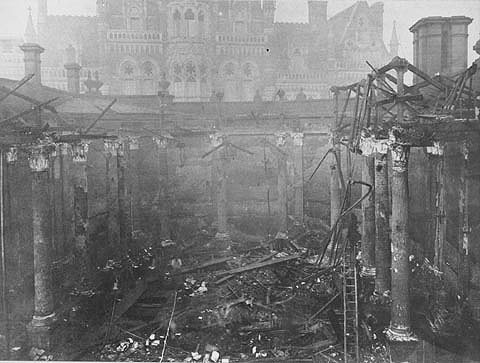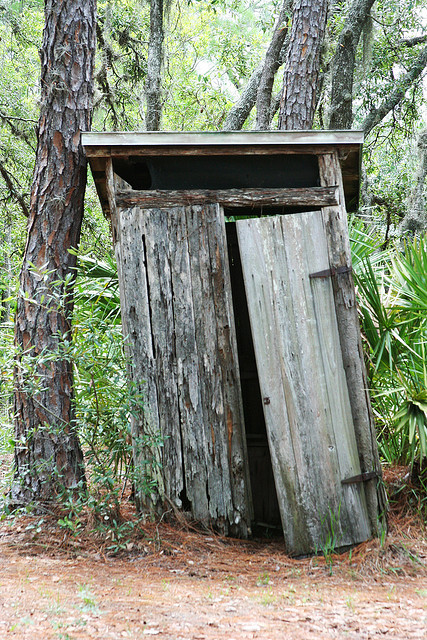On Thursday 23 July I attended New directions in making history at the State Library of Victoria, part of the Making public histories seminar series. After the presentations the discussion was opened up to the floor. The first contribution (which was taken as a comment) came from an audience member who seemed to have a deep distrust of the sustainability of anything digital. His approach: storing around 3,000 hardcopy files, with a preference for material printed on archival paper.
The resilience of the physical and fragility of the digital is a common theme, reinforced by stories such as the one about Brewster Kahle, founder of the internet archive, storing physical books in shipping containers in Richmond, California. What does this say about confidence levels when it comes to our ability to maintain digital content? I have used this story myself when talking about preservation, just as I have talked of the slow decline of the physical when compared to digital files which can disappear or be rendered inaccessible by a single failure. But the day after the seminar, as I went for a walk (my primary purpose being to try and formulate a snappy title for a proposed journal paper) my mind wandered back to this idea.
There are many issues unique to digital preservation. Hardware and software is required to read a PDF file, whereas I can pick up the same document in print and – provided there is light and I’m wearing my glasses – can read it without worrying about electricity, tools, or software versioning. In a recent John Oliver segment, he noted that food past it’s use-by date is not like an old iPhone app after an operating system update – it doesn’t become incompatible with your mouth. Similarly, the printed version of my 1999 Honours thesis is not incompatible with my eyes and brain. I can just pull it out of a box and read it. Accessing the digital copy would require a 3.5″ disk drive and Word for Mac. My early university essays would require Wordperfect, or a program that can convert Wordperfect files to another format. I didn’t know about format migration at the time, and haven’t had a chance in recent years to try and recover what may be lost for ever in its digital form; but not to worry – I have hard copies.
All this seems to support our audience member and his faith in the physical. But it’s not that simple.
For reasons I won’t go into here I still use a paper diary to keep track of all my meetings, appointments, deadlines and other commitments. If, in some nightmarish future, I happen to leave my diary in a cafe, my world would fall apart for several weeks at least, maybe longer. If I leave my laptop behind I might be out of pocket, but I could be up and running with 99.9% of my content accessible within minutes. Through a combination of file management, cloud storage and backup processes (including an external drive at home, and access to a fully-mirrored server in my university’s data centre) I have confidence my digital life – at least with regard to my writing and research – is safe from all but the most catastrophic event.
But of course, our audience member might state. That’s because you backup – many people don’t – and have processes and measures in place. If you don’t have those, your digital content is at risk!
Let’s consider physical content for a moment. I have already noted some of its advantages, and don’t intend to counter here by outlining all the advantages of the digital, like searchability, discoverability, accessiblity, manipulability, reusability, and all the other ‘-bilities’ we could conjur. Let’s just consider preservation of the stuff over time. If you are reliant on physical copies stored in your office or your house, this strategy is not free from risk. Your records are susceptible to fire, flood, theft, pests, mould, and more.
An office in a university is protected from these by a range of measures. Climate control helps prevent mould growth. Rules about food storage, along with regular cleaning and maintenance of the building, reduce the likelihood of mice or other infestations. Keys, swipe cards, security systems and security guards help prevent theft or malicious damage. We are so familiar with these elements of contemporary life we barely notice them, but they help keep our physical records safe.
Fire is perhaps the greatest risk to paper records. Wikipedia has a list of destroyed libraries, illustrated by this picture of Birmingham Central Library from 1879.
Considering our hypothetical university office, there are fire alarms and sprinkler systems installed to reduce the chances of this type of damage, with firemen on call 24 hours a day with trucks, hoses and pumps which can hook into hydrants and underground water mains. Fire prevention strategies means their services are rarely required. There are regulations regarding electrical wiring, safety switches, heaters and other devices. Every year an electrician comes around to check and tag power cords, or to report any that are faulty. And the Building Code of Australia provides an extensive set of technical provisions for designers and builders, which results in documents like this outlining floor coverings, ceiling material, and specifications for wall construction, along with lists like the ‘Spread of Flame Index’ and ‘Smoke Developed Index’ for untreated plywood, arranged by species of tree.
I could go on. In short, significant damage to physical collections is thankfully rare, in large part because there is legislation, regulation and a whole industry of inspectors and other professionals all dedicated to ensuring the buildings in which we live, work and store our files don’t burn down, flood, corrode, or simply collapse.
This type of infrastructure and support – near ubiquitous in the built environment of cities like Melbourne, where I am based – is more scarce in the digital world. As a result, we need to be much more careful about where and how we store our content, and we need to consciously think through what is a safe environment and what is not. I use backup systems, sustainable file types, workflow processes, and the support of system administrators, reliable cloud services and other professionals to ensure my digital research is stored with minimal risk.
In contrast, let’s say you store all your research on a laptop which hasn’t been checked or serviced since you set it up in 2010, and you intermittently copy a few important files onto the USB stick you keep in your pocket. If this is the case (and I’ve seen it more than once) you may be unsurprised to know that your digital research material is at much greater risk than your physical files. That is due less to the ‘fragility of the digital’ and more to the substantial infrastructure society has established to protect physical assets, combined with a widespread lack of understanding about how to create, identify or access its digital equivalent.
If we start comparing the physical and digital without such an understanding, we might as well be comparing the file storage potential of an office and an outhouse.



July 30, 2015 at 2:07 pm
Hi Mike,
This blog post crossed my Twitter feed at just the right moment. I’ve just started a digital preservation subject this semester and so far many of the readings have been about the pitfalls of digital preservation compared to print (obsolescence, benign neglect and all that). I’m sure this is just to highlight how the two must be approached differently, but when lumped with all these readings at once you kind of get the impression that it’s viewed as all too hard. But this post made me step back and think, what’s the point of comparing the two at all? They are different and therefore must be managed differently. It’s that simple. It’s not like digital is going away anytime soon, we just have to get on with it as best we can!
Thanks,
Sarah
July 30, 2015 at 3:05 pm
Good to hear it was useful – thanks Sarah!
While there are many challenges, there are also many advantages and the things that make digital preservation difficult are also the things that make digital stuff so useful – it’s manipulable, extensible, easily copied, supports complex structures, can be multi-media, etc.
I think the main issue here is to be able to look at any sort of preservation critically but also with as much knowledge about the situation as possible. Without knowledge, the debate (on both sides) just turns into cliches and scare-mongering.
Good luck with your studies!